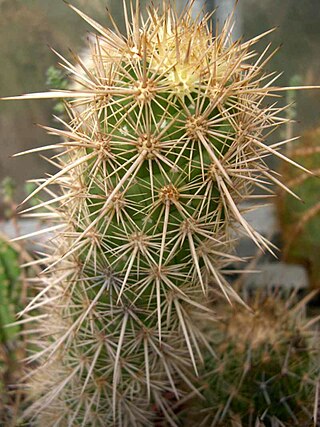
Cochemiea tetrancistra is a species of fishhook cactus known by the common name common fishhook cactus. It is native to the Mojave and Sonoran Deserts of northern Mexico and the southwestern United States, where it grows in a variety of desert habitat types.

Cochemiea grahamii is a species of cactus also known by the names Arizona fishhook cactus and Graham's nipple cactus.

Cochemiea barbata is a small cactus native to Chihuahua, Sonora, and Durango, with the common name greenflower nipple cactus.

Cochemiea conoidea, common name Texas cone cactus or Chihuahuan beehive, is a species of cactus native to southern United States to central Mexico.

Cochemiea boolii is a species of cactus in the subfamily Cactoideae with pink-petaled flowers.

Cochemiea mainiae is a species of cactus in the subfamily Cactoideae, with the common name counterclockwise nipple cactus.

Cochemiea goodridgei is a species of plant in the family Cactaceae. It is endemic to Mexican state Baja California.

Ferocactus gracilis, the fire barrel cactus, is a species of Ferocactus from Northwestern Mexico. This cactus gets its common name from the striking red coloration of its defensive spines and flowers.

Cochemiea blossfeldiana is a species of Cochemiea found in Mexico.

Cochemiea poselgeri is a species of Cochemiea found in Mexico

Cochemiea saboae is a species of Cochemiea found in Mexico.

Cochemiea capensis is a species of Cochemiea found in Mexico.

Cochemiea schumannii is a species of Cochemiea found in Mexico.

Cochemiea theresae is a species of cactus in the subfamily Cactoideae.
Cochemiea cerralboa is a species of Cochemiea found in Mexico.

Cochemiea halei is a species of Cochemiea found in Mexico.

Cochemiea phitauiana is a species of Cochemiea found in Mexico.

Cochemiea palmeri is a species of Cochemiea found in Mexico.

Echinocereus brandegeei is a species of cactus native to Mexico.

Echinocereus maritimus is a species of cactus native to Mexico.






















